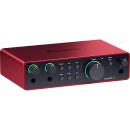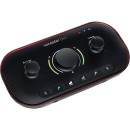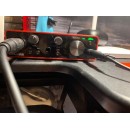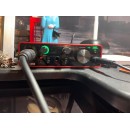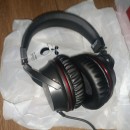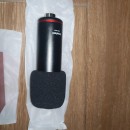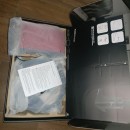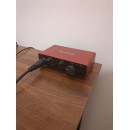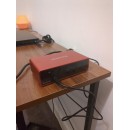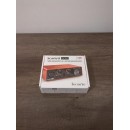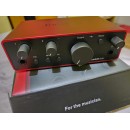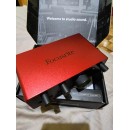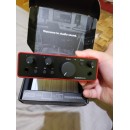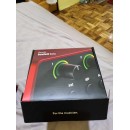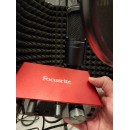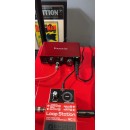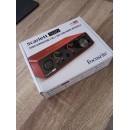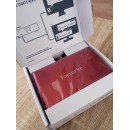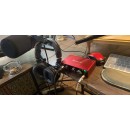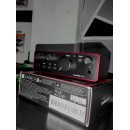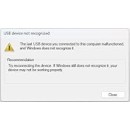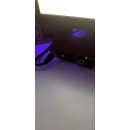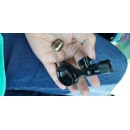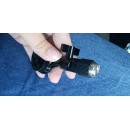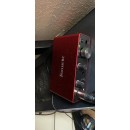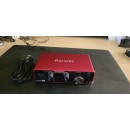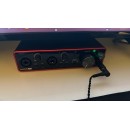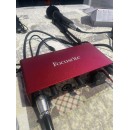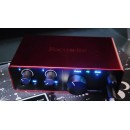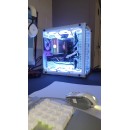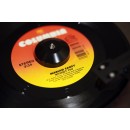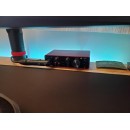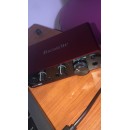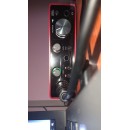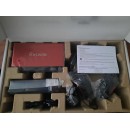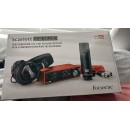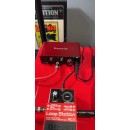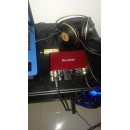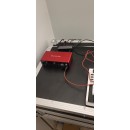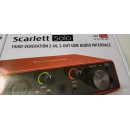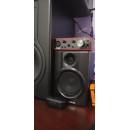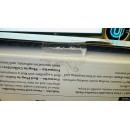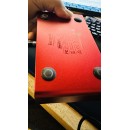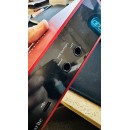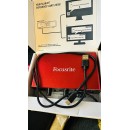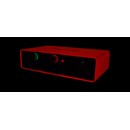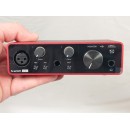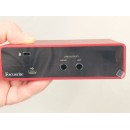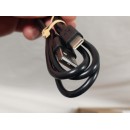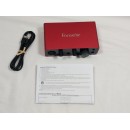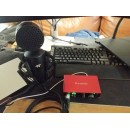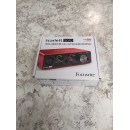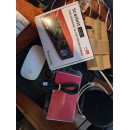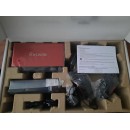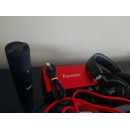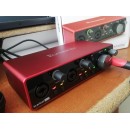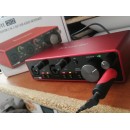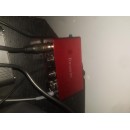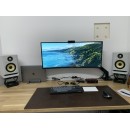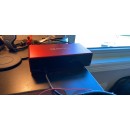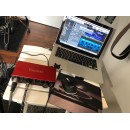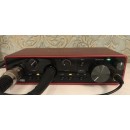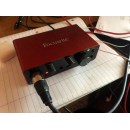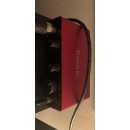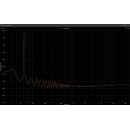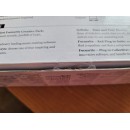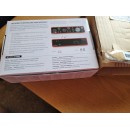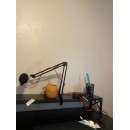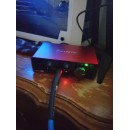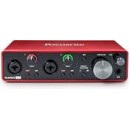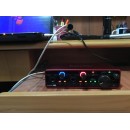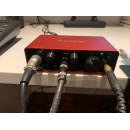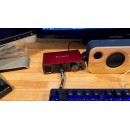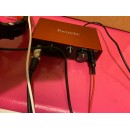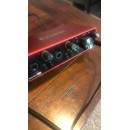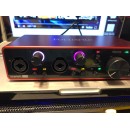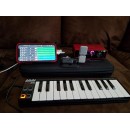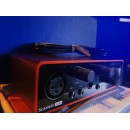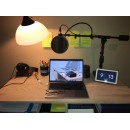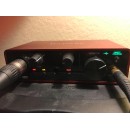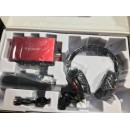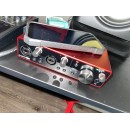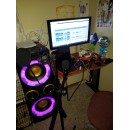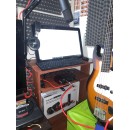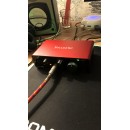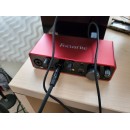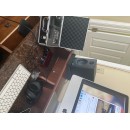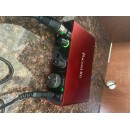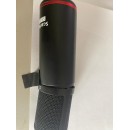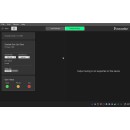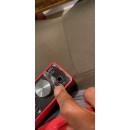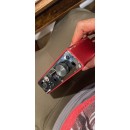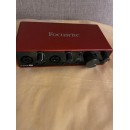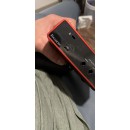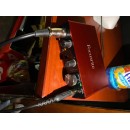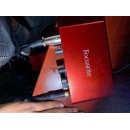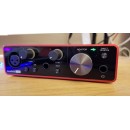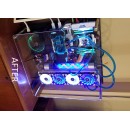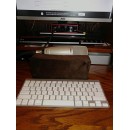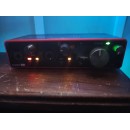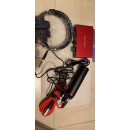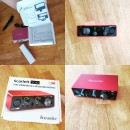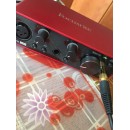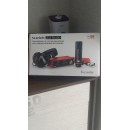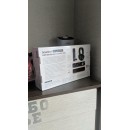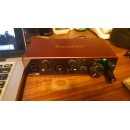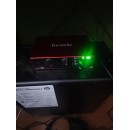Focusrite Vocaster Two vs Scarlett 2i2: Comprehensive Comparison
The Focusrite Vocaster Two USB-C Audio Interface is designed specifically for podcasters and content creators who require high-quality audio input and output capabilities. It features two XLR microphone inputs with high-gain preamps, making it perfect for recording interviews, dual-presenter podcasts, or any project requiring multiple mic inputs. The interface is equipped with a USB-C connection, ensuring fast and reliable data transfer to your computer or recording device. Additionally, the Vocaster Two includes features like automatic gain adjustment and enhanced audio processing, which simplify the setup process and deliver professional sound quality with minimal effort.
In contrast, the Focusrite Scarlett 2i2 USB-C Audio Interface (4th Generation) is more versatile, catering not only to podcasters but also to musicians and producers seeking superior audio fidelity for recording instruments and vocals. This interface is part of Focusrite's renowned Scarlett series, known for its robust build quality and exceptional sound performance. The Scarlett 2i2 offers two improved preamps with adjustable gain controls, including the Air mode that adds high-end detail to your recordings. Like the Vocaster Two, it utilizes a USB-C connection for seamless integration with modern devices, but it also includes updated converters that deliver up to 24-bit/192kHz resolution for pristine audio capture.
Both interfaces provide excellent audio quality and are equipped with essential features for their respective target audiences. However, the Vocaster Two is tailored more towards podcasters with its user-friendly setup and broadcast-ready enhancements, while the Scarlett 2i2 is ideal for musicians and producers who need flexibility and high-resolution audio capabilities. The choice between the two will largely depend on the user's specific needs and the type of content they wish to create.
In the rest of this article, we will delve into a detailed comparison of the Focusrite Vocaster Two and the Focusrite Scarlett 2i2 (4th Generation) USB-C Audio Interfaces. We will explore their specifications, advantages, and disadvantages to help you make an informed decision. Whether you are a professional audio engineer, a podcaster, or a music enthusiast, understanding these key differences will guide you in choosing the right interface for your needs.
In-Depth Comparison of Specifications, Advantages, and Disadvantages
| User Rating Based on Analysis of Reviews | |
|---|---|
|
Show More |
| Pros: | |
|---|---|
|
|
| Cons: | |
|---|---|
|
|
| Find Best Price | Find Best Price |
| Key Specs | |
|---|---|
| Channels of I/O | |
| Analog: 2 Inputs / 2 Outputs at 192 kHz |
Analog: 2 Input / 2 Output Digital: Digital I/O |
| Maximum Sampling Rate | |
| 192 kHz / 24-Bit | 48 kHz / 24-Bit |
| Number of Microphone Inputs | |
| 2 | 2 |
| Analog Audio I/O | |
| 2x XLR 3-Pin Balanced Mic Input 2x 1/4" TRS Balanced/Unbalanced Line/Hi-Z Input (Front Panel) 2x 1/4" TRS Balanced Monitor Output 1x 1/4" TRS Headphone Output (Front Panel) |
2x XLR 3-Pin Balanced Mic Input 1x 1/8" / 3.5 mm TRRS Unbalanced Smartphone In/Out 2x 1/4" TRS Unbalanced Headphone Output 2x 1/4" TRS Balanced Monitor Output |
| Digital Audio I/O | |
| Host Connection | |
| 1x USB-C | 1x USB-C (Class-Compliant) |
| OS Compatibility | |
| macOS Windows |
macOS Windows iPadOS |
| Power Requirements | |
| USB Bus Power, USB Power Adapter (Not Included) | AC/DC Power Adapter (Not Included) or USB Bus Power |
The Focusrite Vocaster Two USB-C Audio Interface offers a total of 2 analog inputs and 2 outputs, with a maximum sampling rate of 48 kHz / 24-Bit. It features 2 microphone inputs, along with various other audio connections including 1x 1/8" / 3.5 mm TRRS unbalanced smartphone in/out and 2x 1/4" TRS balanced monitor outputs. This interface is designed for ease of use with a USB-C host connection and is compatible with macOS, Windows, and iPadOS. Power can be supplied via an AC/DC power adapter or through USB bus power.Show More
In contrast, the Focusrite Scarlett 2i2 USB-C Audio Interface (4th Generation) boasts a higher maximum sampling rate of 192 kHz / 24-Bit while also providing 2 microphone inputs and 2 inputs/outputs configuration. This interface includes 2x XLR 3-Pin balanced mic inputs and 2x 1/4" TRS balanced/unbalanced line/Hi-Z inputs, along with 1x 1/4" TRS headphone output and 2x 1/4" TRS balanced monitor outputs. It connects via USB-C and is compatible with macOS and Windows, relying on USB bus power or an optional USB power adapter.
Overall, while both interfaces provide 2 microphone inputs and a USB-C connection, the Focusrite Scarlett 2i2 stands out with its superior maximum sampling rate of 192 kHz and the additional line/Hi-Z inputs, making it suitable for a wider range of professional audio applications. Conversely, the Focusrite Vocaster Two is tailored more toward podcasters and streamers, featuring smartphone connectivity, which may appeal to content creators looking for simpler setups.
| General | |
|---|---|
| Channels of I/O | |
| Analog: 2 Inputs / 2 Outputs at 192 kHz |
Analog: 2 Input / 2 Output Digital: Digital I/O |
| Built-In DSP | |
| Maximum Sampling Rate | |
| 192 kHz / 24-Bit | 48 kHz / 24-Bit |
| Number of Microphone Inputs | |
| 2 | 2 |
| Built-In Microphone | |
| Input Level Adjustment | |
| 2x Knob | 1x Knob |
| Expansion Slots | |
The Focusrite Vocaster Two USB-C Audio Interface offers a straightforward setup with 2 Analog Inputs and 2 Outputs, making it suitable for podcasters and content creators. It operates at a maximum sampling rate of 48 kHz / 24-Bit, which is adequate for basic recording needs. The interface features 1 Input Level Adjustment Knob, allowing for easy control of the microphone input levels. However, it lacks any built-in DSP and digital I/O capabilities, which may limit its versatility for more advanced audio processing needs.Show More
In contrast, the Focusrite Scarlett 2i2 USB-C Audio Interface (4th Generation) is designed for users seeking higher audio fidelity, boasting the same 2 Analog Inputs and 2 Outputs but with a significantly enhanced maximum sampling rate of 192 kHz / 24-Bit. This makes it a superior choice for professional recording environments where audio quality is paramount. The interface features 2 Input Level Adjustment Knobs, providing more granular control over each microphone input, which can enhance the overall recording experience. Like the Vocaster, it does not include built-in DSP or expansion slots.
In summary, while both the Focusrite Vocaster Two and the Focusrite Scarlett 2i2 are equipped with 2 Microphone Inputs and lack built-in microphones, the Scarlett 2i2 stands out with its higher sampling rate and dual level adjustment controls. For users prioritizing audio quality and precision, the Scarlett 2i2 is the preferred option, while the Vocaster Two serves well for simpler recording tasks.
| Signal Processing | |
|---|---|
| Gain/Trim Range | |
| Mic/Line Inputs: Up to +69 dB Hi-Z Inputs: 62 dB |
Up to 70 dB |
The Focusrite Vocaster Two USB-C Audio Interface features a gain/trim range of up to 70 dB, allowing for significant amplification of microphone signals, which is ideal for podcasting and vocal recordings. However, it does not include a pad option, which may limit the handling of louder sound sources. The interface does have a mute function for each input channel, providing flexibility in managing audio during recording sessions.Show More
In contrast, the Focusrite Scarlett 2i2 USB-C Audio Interface (4th Generation) offers a gain/trim range for microphone and line inputs of up to +69 dB, and for Hi-Z inputs, it provides a gain of 62 dB. This slightly lower gain range compared to the Vocaster might be a consideration for users who require high-level amplification. The Scarlett 2i2 also lacks a pad feature, similar to the Vocaster, which could be a drawback for those working with high-output instruments.
While both interfaces excel in their respective applications, the choice between the two may ultimately depend on specific recording needs. The Vocaster Two is tailored for podcasting with its dedicated input management, while the Scarlett 2i2 remains a versatile option for musicians and general recording applications.
| Connectivity | |
|---|---|
| Analog Audio I/O | |
| 2x XLR 3-Pin Balanced Mic Input 2x 1/4" TRS Balanced/Unbalanced Line/Hi-Z Input (Front Panel) 2x 1/4" TRS Balanced Monitor Output 1x 1/4" TRS Headphone Output (Front Panel) |
2x XLR 3-Pin Balanced Mic Input 1x 1/8" / 3.5 mm TRRS Unbalanced Smartphone In/Out 2x 1/4" TRS Unbalanced Headphone Output 2x 1/4" TRS Balanced Monitor Output |
| Phantom Power | |
| 48 V, Selectable On/Off | 48 V, Selectable On/Off (on 2 Channels) |
| Digital Audio I/O | |
| Host Connection | |
| 1x USB-C | 1x USB-C (Class-Compliant) |
| Host Connection Protocol | |
| USB 2.0 | USB 3.0 / 3.1/3.2 Gen 1 |
| USB (Non-Host) | |
| 1x USB-C (Power Input) | |
| Sync I/O | |
| Network I/O | |
| MIDI I/O | |
| Wireless | |
| Bluetooth | |
When comparing the Focusrite Vocaster Two USB-C Audio Interface and the Focusrite Scarlett 2i2 USB-C Audio Interface (4th Generation), both devices offer a similar analog audio I/O configuration with 2x XLR 3-Pin Balanced Mic Inputs. However, the Vocaster Two stands out with an additional 1x 1/8" / 3.5 mm TRRS Unbalanced Smartphone In/Out, making it more versatile for integrating mobile devices into your setup. The Scarlett 2i2, on the other hand, includes 2x 1/4" TRS Balanced/Unbalanced Line/Hi-Z Inputs, which adds flexibility for connecting instruments directly.Show More
In terms of headphone outputs, the Vocaster Two provides 2x 1/4" TRS Unbalanced Headphone Outputs, allowing multiple users to monitor simultaneously. The Scarlett 2i2 has a single 1x 1/4" TRS Headphone Output on the front panel, which may be less convenient for collaborative sessions. Both interfaces feature 48 V Phantom Power that is selectable on/off, ensuring compatibility with condenser microphones.
Regarding digital connectivity, neither interface features digital audio I/O, sync I/O, network I/O, or MIDI I/O. The Vocaster Two connects via USB-C using a USB 3.0 / 3.1/3.2 Gen 1 protocol, while the Scarlett 2i2 utilizes a USB 2.0 protocol. The Vocaster Two does not have a non-host USB connection, whereas the Scarlett 2i2 includes 1x USB-C (Power Input), allowing for additional power management options. Furthermore, the Vocaster Two offers wireless connectivity via Bluetooth, which is absent in the Scarlett 2i2.
In summary, the Focusrite Vocaster Two is ideal for those looking to integrate mobile devices and require multiple headphone outputs. In contrast, the Focusrite Scarlett 2i2 is better suited for direct instrument connections and offers a more traditional layout for audio recording. Each device has its unique strengths, catering to different user needs and preferences.
| Performance | |
|---|---|
| Frequency Response | |
| XLR Mic Inputs: 20 Hz to 20 kHz ±0.06 dB 1/4" Line Inputs: 20 Hz to 20 kHz 0.05 dB 1/4" Hi-Z Inputs: 20 Hz to 20 kHz 0.15 dB |
Inputs: 20 Hz to 20 kHz +0/-0.5 dB 1/8" / 3.5 mm Line Outputs: 20 Hz to 20 kHz 1/4" Line Outputs: 20 Hz to 20 kHz ±0.15 dB 1/4" Headphone Outputs: 20 Hz to 20 kHz ±0.5 dB |
| Maximum Input Level | |
| XLR Mic: 16 dBu 1/4" Line: 22 dBu 1/4" Hi-Z: 12 dBu |
Mic Inputs: +12.5 dBu (Min Gain) Aux Inputs: +1 dBu |
| Maximum Output Level | |
| 1/4" Line: +16 dBu |
1/4" Line Outputs: +14 dBu 1/4" Headphone Outputs: +6.5 dBu at 0 dBFS 1/8" / 3.5 mm Aux Outputs: -26 dBu 1/8" / 3.5 mm Line Outputs: -24.5 dBu |
| Headphone Output Power | |
| 1/4": 32 mW into 33 Ohms 22 mW into 300 Ohms |
28 mW into 33 Ohms 8.5 mW into 270 Ohms |
| Impedance | |
| XLR Mic Inputs: 3 Kilohms 1/4" Line Inputs: 60 Kilohms 1/4" Hi-Z Inputs: 1 Megohms 1/4" Line Outputs: 100 Ohms 1/4" Headphone Outputs: < 50 Ohm |
Mic Inputs: 3 Kilohms Aux Inputs: 18 Kilohms 1/4" Line Outputs: 440 Ohms 1/4" Headphone Outputs: 5 Ohms 1/8" / 3.5 mm Outputs: 220 Ohms |
| THD+N | |
| XLR Mic Inputs: -100 dB (at 8 dB Gain) 1/4" Line Inputs: -100 dB (at 8 dB Gain) 1/4" Hi-Z Inputs: -80 dB (at Minimum Gain) 1/4" Line Outputs: -109 dB 1/4" Headphone Outputs: -99 dB (at 33 Ohms) -108 dB (at 300 Ohms) Digital A/D Converters: -110 dB Digital D/A Converters: -115 dB |
Inputs: ≤ -94 dB 1/4" Line Outputs: ≤ -96 dB 1/4" Headphone Outputs: -96 dB 1/8" / 3.5 mm Outputs: -73 dB |
When comparing the Focusrite Vocaster Two USB-C Audio Interface and the Focusrite Scarlett 2i2 USB-C Audio Interface (4th Generation), both devices exhibit impressive specifications tailored for audio professionals. The Vocaster Two features a frequency response of 20 Hz to 20 kHz across its inputs and outputs, maintaining a tight tolerance of +0/-0.5 dB for mic inputs, while the Scarlett 2i2 also offers a similar frequency response of 20 Hz to 20 kHz but with a slightly tighter tolerance of ±0.06 dB for XLR mic inputs. This slight edge in frequency response consistency can be significant for critical listening applications.Show More
In terms of maximum input levels, the Vocaster Two supports +12.5 dBu for mic inputs and +1 dBu for aux inputs, while the Scarlett 2i2 boasts higher levels, reaching 16 dBu for XLR mic inputs and 22 dBu for 1/4" line inputs. This makes the Scarlett 2i2 more capable of handling louder sound sources without distortion. Regarding output levels, the Vocaster Two delivers +14 dBu from its 1/4" line outputs, compared to the Scarlett 2i2's +16 dBu, offering a slight advantage for the latter in output capacity.
Headphone output power is another area of difference; the Vocaster Two provides 28 mW into 33 Ohms and 8.5 mW into 270 Ohms, while the Scarlett 2i2 offers 32 mW into 33 Ohms and 22 mW into 300 Ohms. This indicates that the Scarlett 2i2 can drive headphones more effectively, especially at higher impedances. Furthermore, the impedance specifications reveal that the Vocaster Two features a mic input impedance of 3 Kilohms, similar to the Scarlett 2i2, which maintains the same input impedance for XLR mic inputs.
Finally, both interfaces demonstrate exceptional total harmonic distortion plus noise (THD+N) performance, with the Vocaster Two achieving ≤ -94 dB for inputs and ≤ -96 dB for line outputs. The Scarlett 2i2 excels with -100 dB for XLR mic and line inputs and -109 dB for line outputs. This suggests that the Scarlett 2i2 may provide cleaner audio signals, especially at lower gain settings. Overall, both interfaces have unique strengths, with the Scarlett 2i2 leaning towards higher input/output capacity and dynamic range, while the Vocaster Two offers robust features specifically designed for podcasting and content creation.
| Digital Audio | |
|---|---|
| Sample Rates | |
| 44.1 / 48 / 88.2 / 96 / 176.4 / 192 kHz | Up to 48 kHz |
| Bit Depths | |
| 24-Bit | 24-Bit |
| Sync Sources | |
| Internal | Internal |
When comparing the Focusrite Vocaster Two USB-C Audio Interface and the Focusrite Scarlett 2i2 USB-C Audio Interface (4th Generation), one of the key specifications to consider is the sample rates. The Vocaster Two supports sample rates of up to 48 kHz, making it suitable for various recording applications. In contrast, the Scarlett 2i2 offers a more extensive range of sample rates, including 44.1, 48, 88.2, 96, 176.4, and 192 kHz, providing greater flexibility for high-quality audio production.Show More
Both interfaces share a bit depth of 24-Bit, ensuring high dynamic range and audio fidelity in recordings. This similarity means that users of either interface can expect professional-quality sound. However, the Vocaster Two does not feature sample rate conversion, while the Scarlett 2i2 does not specify this capability but presents a broader selection of sample rates, which could imply its versatility in handling different recording scenarios.
In terms of sync sources, both the Vocaster Two and Scarlett 2i2 utilize internal sync, making them straightforward to set up and use. This feature allows for seamless integration into various recording setups without the need for external synchronization methods.
| Audio Storage & Playback | |
|---|---|
| Media/Memory Card Slot | |
The Focusrite Vocaster Two USB-C Audio Interface and the Focusrite Scarlett 2i2 USB-C Audio Interface (4th Generation) both offer robust features for audio recording, yet they cater to slightly different user needs. Both models lack a Media/Memory Card Slot, which means users will need to rely on external storage solutions for their recordings. This similarity indicates that neither interface is primarily designed for standalone recording directly onto a memory card.Show More
When comparing the two, the Vocaster Two is tailored more towards podcasters and content creators, providing features such as enhanced vocal processing and easy-to-use presets. On the other hand, the Scarlett 2i2 is often favored by musicians and engineers, offering a more traditional interface with high-quality preamps and instrument inputs. The choice between these two will largely depend on the specific needs of the user, whether it be podcasting or music production.
Both interfaces are equipped with USB-C connectivity, ensuring fast data transfer and compatibility with modern devices. Additionally, they both feature high-resolution audio capabilities, making them suitable for professional-grade recordings. However, the overall user experience may differ due to the distinct focus of each unit, making it essential for potential buyers to consider their primary use case before making a decision.
| Compatibility | |
|---|---|
| OS Compatibility | |
| macOS Windows |
macOS Windows iPadOS |
| Mobile App Compatible | |
| Yes: iPadOS Only | Yes: iPadOS Only |
The Focusrite Vocaster Two USB-C Audio Interface and the Focusrite Scarlett 2i2 USB-C Audio Interface (4th Generation) are both highly regarded options for audio recording, but they differ in specific features. The Vocaster Two is compatible with macOS, Windows, and iPadOS, allowing for versatility across different operating systems. Additionally, it supports mobile device compatibility with iPads that have a USB-C connection, making it a suitable choice for mobile recording setups. However, it requires an available USB-A port for operation, which could be a limitation for users with newer devices that primarily feature USB-C ports.Show More
On the other hand, the Focusrite Scarlett 2i2 USB-C Audio Interface (4th Generation) also supports macOS and Windows systems, but lacks the iPad mobile device compatibility that the Vocaster Two offers. Similar to the Vocaster Two, it is mobile app compatible with iPadOS, but the absence of specific mobile device compatibility may make it less appealing for users focused on iPad recording. Overall, while both interfaces are robust in their functionality, the key differences lie in the Vocaster Two's added versatility for iPad users and its requirement for USB-A ports, compared to the Scarlett 2i2's broader operating system compatibility without mobile device support.
| Power | |
|---|---|
| Power Requirements | |
| USB Bus Power, USB Power Adapter (Not Included) | AC/DC Power Adapter (Not Included) or USB Bus Power |
| AC/DC Power Adapter | |
| 5 VDC at 900 mA | 5 VDC at 1 A (Not Included) |
| Power Consumption | |
| 4.5 W | 4.5 W (Maximum) |
The Focusrite Vocaster Two USB-C Audio Interface operates with power requirements that include an AC/DC power adapter (not included) or can be powered through USB bus power. It requires a 5 VDC at 1 A AC/DC power adapter, which is not provided with the product. The maximum power consumption for this interface is 4.5 W.Show More
In contrast, the Focusrite Scarlett 2i2 USB-C Audio Interface (4th Generation) is designed to be powered primarily through USB bus power, though it can also use a USB power adapter (also not included). This model requires a 5 VDC at 900 mA AC/DC power adapter. Similar to the Vocaster Two, its maximum power consumption is 4.5 W.
Both interfaces have the same maximum power consumption of 4.5 W, but the Vocaster Two has a slightly higher requirement for its AC/DC power adapter at 1 A compared to the Scarlett 2i2's 900 mA. This could be a consideration for users looking for efficiency and convenience in their power needs.
| Physical | |
|---|---|
| Dimensions | |
| 7.1 x 4.6 x 1.87" / 18 x 11.7 x 4.75 cm | 8.8 x 4.4 x 2" / 22.4 x 11.3 x 5 cm |
| Weight | |
| 1.3 lb / 595.0 g | 0.8 lb / 0.4 kg (without Accessories) |
When comparing the Focusrite Vocaster Two and the Focusrite Scarlett 2i2 USB-C Audio Interface (4th Generation), one of the notable differences lies in their dimensions and weight. The Vocaster Two measures 8.8 x 4.4 x 2 inches (22.4 x 11.3 x 5 cm) and weighs 0.8 lb (0.4 kg) without accessories, making it a compact and lightweight option ideal for portable setups. In contrast, the Scarlett 2i2 has a smaller footprint at 7.1 x 4.6 x 1.87 inches (18 x 11.7 x 4.75 cm) but weighs 1.3 lb (595 g), which may make it slightly less convenient for mobility.Show More
Additionally, the design and intended use of each interface cater to different audiences. The Vocaster Two is specifically optimized for podcasters and content creators, featuring dedicated controls and a user-friendly interface that enhances the recording experience. On the other hand, the Scarlett 2i2 is designed for a broader range of applications, including music production and live performances, providing versatility for musicians and audio engineers alike.
Overall, while both the Focusrite Vocaster Two and the Focusrite Scarlett 2i2 offer USB-C connectivity and high-quality audio interfaces, the choice between them may depend on the user's specific needs. The Vocaster Two excels in portability and podcasting features, whereas the Scarlett 2i2 shines in its versatility for various audio tasks.
| Packaging Info | |
|---|---|
| Package Weight | |
| 1.9 lb | 1.915 lb |
| Box Dimensions (LxWxH) | |
| 8.2 x 7 x 2.6" | 10.8 x 7.6 x 3.1" |
The Focusrite Vocaster Two USB-C Audio Interface has a package weight of 1.915 lb and dimensions of 10.8 x 7.6 x 3.1 inches. This larger size may indicate a more robust build or additional features aimed at podcasting and content creation, making it suitable for users who prioritize versatility in their recording setup.Show More
In contrast, the Focusrite Scarlett 2i2 USB-C Audio Interface (4th Generation) is slightly lighter at 1.9 lb and has more compact dimensions of 8.2 x 7 x 2.6 inches. The smaller size makes it more portable, which could be an advantage for musicians and audio engineers who need a compact solution for recording on the go.
While both interfaces are designed to provide high-quality audio capture, the differences in weight and dimensions suggest that the Vocaster Two is more tailored for immersive podcasting experiences, while the Scarlett 2i2 focuses on a streamlined, portable design for musicians and general audio recording. Users should consider their specific needs when choosing between these two options.
| Customer Images | |
|---|---|
| Videos | |
|---|---|
|
|
|
